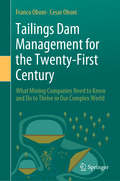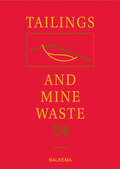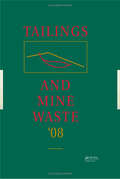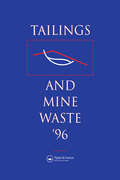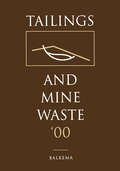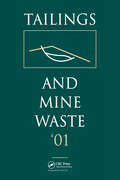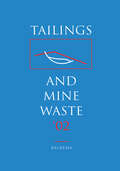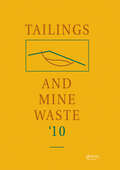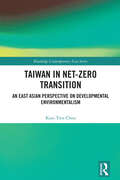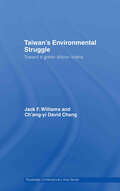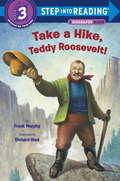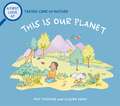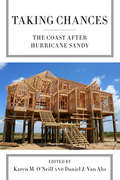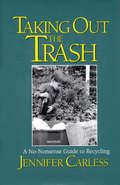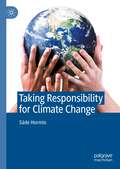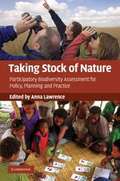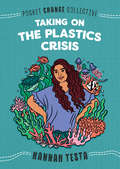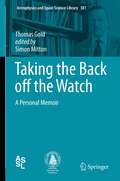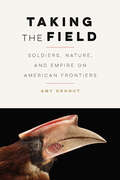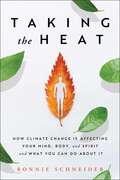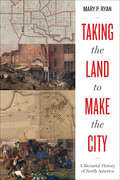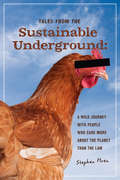- Table View
- List View
Tailings Dam Management for the Twenty-First Century: What Mining Companies Need to Know and Do to Thrive in Our Complex World
by Franco Oboni Cesar OboniThis book presents a comprehensive approach to address the need to improve the design of tailings dams, their management and the regulation of tailings management facilities to reduce, and eventually eliminate, the risk of such facilities failing. The scope of the challenge is well documented in the report by the United Nations Environment Program (UNEP) and GRID Arendal entitled “Mine Tailings Storage: Safety Is No Accident,” which was released in October 2017. The report recommends that “Regulators, industry and communities should adopt a shared, zero-failure objective to tailings storage facilities…” and identifies several areas where further improvements are required. In this context, the application of cutting-edge risk-assessment methodologies and risk-management practices can contribute to a significant reduction and eventual elimination of dam failures through Risk Informed Decision Making. As such, the book focuses on identifying and describing the risk-assessment approaches and risk-management practices that need to be implemented in order to develop a way forward to achieve socially acceptable levels of tailings dam risk.
Tailings and Mine Waste '04: Proceedings of the Eleventh Tailings and Mine Waste Conference, 10-13 October 2004, Vail, Colorado, USA
by Linda HinshawWritten by specialists from the mining industry, this collection of over sixty papers from the eleventh annual Tailings and Mine Waste Conference deals with technical capabilities and developments, as well as regulations and environmental concerns. It includes papers on topics such as site characterization, radioactivity and ris
Tailings and Mine Waste '08
by UnknownTailings and Mine Waste08 contains papers from the twelfth annual Tailings and Mine Waste Conference, held by Colorado State University of Fort Collins, Colorado. The purpose of this series of conferences is to provide a forum for discussion and establishment of dialogue among all people in the mining industry and environmental community regardin
Tailings and Mine Waste 1996
by Colorado State UniversityPresents papers on mine and mill tailings and mine waste, as well as current and future issues facing the mining and environmental communities. Subjects related to technical capabilities and developments, regulations and environmental concerns are included.
Tailings and Mine Waste 2000
by A. A. BalkemaThe objective of this text is to provide information on mill tailings and mine waste, and to discuss current and future issues facing the mining and environmental communities. With over 60 papers included.
Tailings and Mine Waste 2001
by NoneThese papers focus on mine and mill tillings and mine waste. The work also contains information on subjects related to: regulations, technical capacities and developments. This guide identifies the current and future issues facing the mining and enviromental concerns.
Tailings and Mine Waste 2002: Proceedings of the 9th International Conference, Fort Collins, Colorado,
by Symposium EditorsThe proceedings in this work present 60 papers on mine and mill tailings and mine waste, as well as current and future issues facing the mining and environmental communities. This includes matters dealing with technical capabilities and developments, regulations, and environmental concerns.
Tailings and Mine Waste 2010
by Chippenham WiltshireTailings and Mine Waste 10 contains the contributions from the 14th annual Tailings and Mine Waste Conference, held by Colorado State University of Fort Collins, Colorado in conjunction with the University of Alberta and the University of British Columbia. The purpose of this series of conferences is to provide a forum for discussion and establish
Taiwan in Net-Zero Transition: An East Asian Perspective of Developmental Environmentalism (Routledge Contemporary Asia Series)
by Kuei Tien ChouChou explores the structural dilemmas, mindsets, challenges, and solutions of the net-zero transition in Taiwan. Using Taiwan as a representative example of the structural challenges faced by East Asian countries in achieving the global net-zero carbon emission goal, the book examines the proposition of developmental environmentalism in the context of East Asia.Taiwan faces diverse challenges, such as internal and external net-zero carbon emission pressures, geopolitical socioeconomic competition, an internal carbon-intensive industrial structure, and the path dependence of the brown economy. Within this framework, the developmental net-zeroism perspective, from the vantage point of developmental environmentalism and the distinctive characteristics of Taiwan, offers insights into the climate governance particularities of East Asian countries as high-carbon manufacturing systems and as part of the global supply chain.A valuable read for researchers and policymakers concerned about the political, economic, and social situations in Asia and Taiwan affecting the net-zero transition.
Taiwan's Environmental Struggle: Toward a Green Silicon Island (Routledge Contemporary Asia Series)
by Jack Williams Ch’ang-yi David ChangTaiwan experienced a highly successful economic transformation in the last 50 years that produced one of Asia’s genuine ‘miracles’ of modern development, in terms of improvement in per capita income and overall quality of material well being for its citizens. The process, though, involved rapid industrialization and urbanization, and breakneck mass consumption, that inevitably resulted in rapid escalation in degradation of the island’s fragile air, water, and land, and produced some of the worst environmental pollution to be found anywhere in Asia This book examines the causes of Taiwan's environmental predicament, engaging in Taiwan's unique geological, geographical, demographical, political, industrial, historical and economic circumstances. In addition, Jack Williams and Ch'ang-yi David Chang assess the efforts of the government, NGOs and private citizens to create a "green" environmentally sustainable island, with a high tech economy based on the silicon chip, the backbone of Taiwan’s highly successful IT industry. Finally the authors discuss what can be done to improve Taiwan's environmental future. As the first commercially available book in English on Taiwan’s environmental problems this is an invaluable read for students and scholars interested in environmental studies, sustainable development and the island of Taiwan.
Take Back the Economy: An Ethical Guide for Transforming Our Communities
by Jenny Cameron Stephen Healy J. K. Gibson-GrahamIn the wake of economic crisis on a global scale, more and more people are reconsidering their role in the economy and wondering what they can do to make it work better for humanity and the planet. In this innovative book, J. K. Gibson-Graham, Jenny Cameron, and Stephen Healy contribute complex understandings of economics in practical terms: what can we do right now, in our own communities, to make a difference? Full of exercises, thinking tools, and inspiring examples from around the world, Take Back the Economy shows how people can implement small-scale changes in their own lives to create ethical economies. There is no manifesto here, no one prescribed model; rather, readers are encouraged and taught how to take back the economy in ways appropriate for their own communities and context, using what they already have at hand. Take Back the Economy dismantles the idea that the economy is separate from us and best comprehended by experts. Instead, the authors demonstrate that the economy is the outcome of the decisions and efforts we make every day. The economy is thus reframed as a space of ethical action—something we can shape and alter according to what is best for the well-being of people and the planet. The book explores what people are already doing to build ethical economies, presenting these deeds as mutual concerns: What is necessary for survival, and what do we do with the surplus produced beyond what will fulfill basic needs? What do we consume, and how do we preserve and replenish the commons—those resources that can be shared to maintain all? And finally, how can we invest in a future worth living in? Suitable for activists and students alike, Take Back the Economy will be of interest to anyone seeking a more just, sustainable, and equitable world.
Take a Hike, Teddy Roosevelt! (Step into Reading)
by Frank Murphy illustrated by Richard WalzA Step 3 Step into Reading Biography Reader about Teddy Roosevelt and his efforts to protect our environment and establish national parks. Teddy battled asthma all his life, and the list of things he shouldn't do was long. But when people told him "you can't," he set about proving them wrong. This book focuses on his inexhaustible enthusiasm and his commitment to preserving America's natural resources. Step 3 Readers feature engaging characters in easy-to-follow plots about popular topics. For children who are ready to read on their own.
Taking Care of Nature: This is our Planet (A First Look At #33)
by Pat ThomasThis reassuring picture book makes children aware of how unique our planet is and why we need to look after it. This book is written from the perspective that we take care of the things we care about and that the rules for taking care of the environment are little different from the rules of everyday living and getting along with others. 'What about you?' questions throughout are useful prompts for understanding things from your child's point of view. Charmingly clear illustrations give readers immediate access to complex situations and feelings Notes for parents and teachers at the back of the book provide valuable advice for how to share this book with your child or class.The superb A First Look At series consists of a number of reassuring picturebooks that give advice and promote interaction between children, parents, and teachers on a wide variety of personal, social and emotional issues Written by a trained psychotherapist, journalist and parent, and illustrated by an experienced children's book artist, this title is part of an acclaimed and successful series of picture-book non-fiction for Early Years. Books in the series give advice and promote interaction between children, parents, and teachers on a wide variety of personal, social and emotional issues. They are excellent tools for teachers to use during classroom discussions.
Taking Care of Where We Live: Restoring Ecosystems (Orca Think #17)
by Merrie-Ellen WilcoxKey Selling Points Introduces readers to STEM concepts, such as ecology and ecosystems, ecosystem services, biodiversity, ecological degradation, climate change, deforestation and how ecological restoration works. Also looks at the role ecological restoration can play in social issues such as fighting poverty and food insecurity. Readers will discover the importance of Traditional Ecological Knowledge (TEK) and how Indigenous knowledge is key to understanding and restoring ecosystems. The United Nations Decade on Ecosystem Restoration launched on June 5 (World Environment Day), 2021, in response to a proposal from more than 70 countries around the world. It encourages young people to become part of #GenerationRestoration. Features restoration projects in different ecosystems (e.g., forests, wetlands, grasslands, islands and marine ecosystems) around the world, such as the Great Green Wall in Africa (the world's largest ecological restoration project), the Ten Billion Tree Tsunami project in northwestern Pakistan (aiming to restore the region's forests and fight the effects of climate change) and the Maiden Island Reef in the Caribbean (the world's largest marine habitat restoration, including both coral reefs and mangrove habitat). The author has a diploma in the restoration of natural systems from the University of Victoria. She spoke with leading experts in the field of ecological restoration during her research for this book. She's published two Footprints titles with Orca, What's the Buzz? and Nature Out of Balance.
Taking Chances: The Coast after Hurricane Sandy
by Joanna Burger Tammy L. Lewis Kenneth A. Gould Robert B. Gramling Mark Alan Hewitt Mariana Leckner Bonnie Mccay Briavel Holcomb Angela Oberg Melanie Mcdermott Steven G. Decker Professor Karen M. O'Neill Patricia M. Clay Daniel Redlaswk Frank A. Felder Clinton J. Andrews Adelle Thomas Lisa L. Colburn Larry Niles Daniel Baldwin Hess David A. Robinson Brian W. Conley James K. Mitchell Ashley Koning Shankar Chandramowli Daniel J. Van Abs Julia FlaggHumanity is deeply committed to living along the world's shores, but a catastrophic storm like Sandy--which took hundreds of lives and caused many billions of dollars in damages--shines a bright light at how costly and vulnerable life on a shoreline can be. Taking Chances offers a wide-ranging exploration of the diverse challenges of Sandy and asks if this massive event will really change how coastal living and development is managed. Bringing together leading researchers--including biologists, urban planners, utilities experts, and climatologists, among others--Taking Chances illuminates reactions to the dangers revealed by Sandy. Focusing on New Jersey, New York, and other hard-hit areas, the contributors explore whether Hurricane Sandy has indeed transformed our perceptions of coastal hazards, if we have made radically new plans in response to Sandy, and what we think should be done over the long run to improve coastal resilience. Surprisingly, one essay notes that while a large majority of New Jerseyans identified Sandy with climate change and favored carefully assessing the likelihood of damage from future storms before rebuilding the Shore, their political leaders quickly poured millions into reconstruction. Indeed, much here is disquieting. One contributor points out that investors scared off from further investments on the shore are quickly replaced by new investors, sustaining or increasing the overall human exposure to risk. Likewise, a study of the Gowanus Canal area of Brooklyn shows that, even after Sandy swamped the area with toxic flood waters, plans to convert abandoned industrial lots around the canal into high-density condominiums went on undeterred. By contrast, utilities, emergency officials, and others who routinely make long-term plans have changed operations in response to the storm, and provide examples of adaptation in the face of climate change. Will Sandy be a tipping point in coastal policy debates--or simply dismissed as a once-in-a-century anomaly? This thought-provoking collection of essays in Taking Chances makes an important contribution to this debate.
Taking Out the Trash: A No-Nonsense Guide To Recycling
by Jennifer CarlessTaking Out the Trash is a practical and useful guide to how individuals, businesses, and communities can help alleviate America's garbage crisis.
Taking Responsibility for Climate Change
by Säde HormioThis book proposes that it is not only states and international bodies that have a responsibility to take action toward mitigating climate change. Other collective agents, such as corporations, need to also come onboard. Additionally, the book argues that climate change is not solely a problem for collective agents, but also for individuals, as they are members of collectives and groups of several kinds. Therefore, framing climate change responsibility exclusively from either the collective or the individual perspective leaves out something crucial: how we all are influenced by the collectives we belong to and how, in turn, collectives are influenced by individuals. The focus of the book is on areas of climate change responsibility that are often left out of the picture or get too little attention in climate ethics, such as carbon inequality within countries. But why should any theoretical arguments about normative issues matter when we have a real-life climate crisis on our hands? Säde Hormio argues that ethical arguments have an important role in setting climate policy: they can highlight what values are at stake and help ground normative arguments in public deliberations.
Taking Stock of Nature: Participatory Biodiversity Assessment for Policy, Planning and Practice
by Anna LawrenceIn a world of increasing demands for biodiversity information, participatory biodiversity assessment and monitoring is becoming more significant. Whilst other books have focused on methods, or links to conservation or development, this book is written particularly for policy makers and planners. Introductory chapters analyze the challenges of the approach, the global legislation context, and the significance of the Millennium Ecosystem Assessment. Specially commissioned case studies provide evidence from 17 countries, by 50 authors with expertise in both biological and social sciences. Ranging from community conservation projects in developing countries to amateur birdwatching in the UK, they describe the context, objectives, stakeholders and processes, and reflect on the success of outcomes. Rather than advocating any particular approach, the book takes a constructively critical look at the motives, experiences and outcomes of such approaches, with cross-cutting lessons to inform planning and interpretation of future participatory projects and their contribution to policy objectives.
Taking Sustainable Cities Seriously: Economic Development, the Environment, and Quality of Life in American Cities
by Kent E. PortneyTaking on the Plastics Crisis (Pocket Change Collective)
by Hannah TestaPocket Change Collective was born out of a need for space. Space to think. Space to connect. Space to be yourself. And this is your invitation to join us."Taking on the Plastics Crisis delivers straightforward advise for getting involved in the global movement to eliminate single-use plastics." -- Booklist, Starred Review"Brief yet inspirational, this story will galvanize youth to use their voices for change."--Kirkus Reviews"Taking on the Plastics Crisis is a sobering and inspiring read by a brilliant young change maker. Now is the time for all of us to come together to solve the plastic pollution crisis."--Ed Begley Jr. (actor and environmental activist)In this personal, moving essay, youth activist Hannah Testa shares with readers how she led a grassroots political campaign to successfully pass state legislation limiting single-use plastics and how she influenced global businesses to adopt more sustainable practices. Through her personal journey, readers can learn how they, too, can follow in Hannah's footsteps and lower their carbon footprint by simply refusing single-use plastics.Pocket Change Collective is a series of small books with big ideas from today's leading activists and artists. In this installment, youth activist Hannah Testa, the founder of Hannah4Change, chronicles both her personal and political mission to save the Earth's oceans by limiting single-use plastic products.
Taking the Back off the Watch
by Simon Mitton Thomas GoldThomas Gold (1920-2004) had a curious mind that liked to solve problems. He was one of the most remarkable astrophysicists in the second half of the twentieth century, and he attracted controversy throughout his career. Based on a full-length autobiography left behind by Thomas Gold, this book was edited by the astrophysicist and historian of science, Simon Mitton (University of Cambridge). The book is a retrospective on Gold's remarkable life. He fled from Vienna in 1933, eventually settling in England and completing an engineering degree at Trinity College in Cambridge. During the war, he worked on naval radar research alongside Fred Hoyle and Hermann Bondi - which, in an unlikely chain of events, eventually led to his working with them on steady-state cosmology. In 1968, shortly after their discovery, he provided the explanation of pulsars as rotating neutron stars. In his final position at Cornell, he and his colleagues persuaded the US Defense Department to fund the conversion of the giant radio telescope at Arecibo in Puerto Rico into a superb instrument for radio astronomy. Gold's interests covered physiology, astronomy, cosmology, geophysics, and engineering. Written in an intriguing style and with an equally intriguing foreword by Freeman Dyson, this book constitutes an important historical document, made accessible to all those interested in the history of science.
Taking the Field: Soldiers, Nature, and Empire on American Frontiers (Many Wests)
by Amy KohoutPublished in Cooperation with the William P. Clements Center for Southwest Studies, Southern Methodist University. In the late nineteenth century, at a time when Americans were becoming more removed from nature than ever before, U.S. soldiers were uniquely positioned to understand and construct nature&’s ongoing significance for their work and for the nation as a whole. American ideas and debates about nature evolved alongside discussions about the meaning of frontiers, about what kind of empire the United States should have, and about what it meant to be modern or to make &“progress.&” Soldiers stationed in the field were at the center of these debates, and military action in the expanding empire brought new environments into play. In Taking the Field Amy Kohout draws on the experiences of U.S. soldiers in both the Indian Wars and the Philippine-American War to explore the interconnected ideas about nature and empire circulating at the time. By tracking the variety of ways American soldiers interacted with the natural world, Kohout argues that soldiers, through their words and their work, shaped Progressive Era ideas about both American and Philippine environments. Studying soldiers on multiple frontiers allows Kohout to inject a transnational perspective into the environmental history of the Progressive Era, and an environmental perspective into the period&’s transnational history. Kohout shows us how soldiers—through their writing, their labor, and all that they collected—played a critical role in shaping American ideas about both nature and empire, ideas that persist to the present.
Taking the Heat: How Climate Change Is Affecting Your Mind, Body, and Spirit and What You Can Do About It
by Bonnie SchneiderFrom meteorologist and Peabody Award–winning journalist Bonnie Schneider, an innovative look at how climate change is already threatening our mental and physical health and practical tips for you to tackle these challenges head on.The impacts of climate change have become dire. Rising temperatures, volatile weather, and poor air quality affect our physical and mental health in dangerous new ways. From increasing the risk of infectious disease to amplifying emotional stress and anxiety—even the healthiest among us are at risk. Bonnie Schneider has tracked environmentally-linked physiological impacts throughout her career as a TV journalist, meteorologist, and the founder of Weather & Wellness©—a platform that explores the connection between weather, climate change, and health. In Taking the Heat, Schneider provides crucial advice from science experts and medical professionals to help you: -Cope with the mental anguish of &“eco-anxiety&” and other climate change fears for our planet&’s future, particularly expressed by millennials and Gen-Z -Identify health hazards caused by extreme heat and air pollution that disproportionally affect low-income and minority communities -Uncover the science behind longer and stronger allergy seasons and learn new ways to reduce your risk of adverse allergic reactions -Detect the increased threat of dangerous pathogens lurking in unexpected places and why we may face future pandemics -Understand how seasonal fluctuations of sunlight, heat, and humidity can not only factor into feelings of depression and anxiety but also can trigger flare-ups for certain auto-immune diseases -Discover how meditation and mindfulness practices can ease the psychological stress that often occurs in the aftermath of devastating natural disasters -Explore how the Earth&’s rising temperatures may rob you of restorative sleep and impair mental sharpness -Learn why increased levels of CO2 in the atmosphere may reduce the availability of what you choose to eat; learn sustainable solutions—from food to fitness - And more! Anchored in the latest scientific research and filled with relatable first-person stories, this book is the one guide you need to navigate the future of your own health—mind, body, and spirit, in a rapidly changing environment.
Taking the Land to Make the City: A Bicoastal History of North America (Lateral Exchanges: Architecture, Urban Development, and Transnational Practices)
by Mary P. RyanThis historical study shows how San Francisco and Baltimore were central to American expansion through the eighteenth and nineteenth centuries. The history of the United States is often told as a movement westward, beginning at the Atlantic coast and following farmers across the continent. But early settlements and towns sprung up along the Pacific as well as the Atlantic, as Spaniards and Englishmen took Indian land and converted it into private property. In this ambitious study of historical geography and urban development, Mary P. Ryan reframes the story of American expansion. Baltimore and San Francisco share common roots as early coastal trading centers immersed in the international circulation of goods and ideas. Ryan traces their beginnings back to the first human habitation of each area, showing how the juggernaut toward capitalism and nation-building could not commence until Europeans had taken the land for city building. She then recounts how Mexican ayuntamientos and Anglo-American city councils pioneered a prescient form of municipal sovereignty that served as both a crucible for democracy and a handmaid of capitalism. Moving into the nineteenth century, Ryan shows how the citizens of Baltimore and San Francisco molded the shape of the modern city: the gridded downtown, rudimentary streetcar suburbs, and outlying great parks. This history culminates in the era of the Civil War when the economic engines of cities helped forge the East and the West into one nation.
Tales From the Sustainable Underground
by Stephen HrenActivists striving for any type of social change often find themselves operating on the fringes of legal and social norms. Many experience difficulties when their innovative ideas run afoul of antiquated laws and regulations that favor a big business energy- and material-intensive approach. Tales From the Sustainable Underground is packed with the stories of just some of these pioneers-who care more for the planet than the rules-whether they're engaged in natural building, permaculture, community development, or ecologically based art. Ride along and meet courageous and inspiring individuals such as:*Solar guru Ed Eaton*Radical urban permaculturists Scott Kellogg and Stacy Pettigrew*Artist, eco-architect, and intuitive builder Matt BuaEqually entertaining and informative, the profiles in this highly original book provide a unique lens through which to view deeper questions about the societal structures that are preventing us from attaining a more sustainable world. By examining such issues as the nature of property rights and the function of art in society, the author raises profound questions about how our social attitudes and mores have contributed to our current destructive paradigm.Tales From the Sustainable Underground is a must-read for sustainability activists in any field, or for anyone who wants to learn about more radical forms of sustainability activities in an entertaining way.Stephen Hren is a restoration carpenter, builder, and teacher who specializes in sustainable design and passive and active solar heating technologies. He is co-author of The Carbon-Free Home and A Solar Buyer's Guide for the Home and Office.
